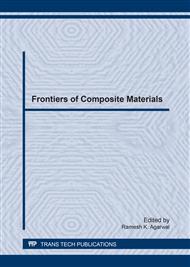[1]
Rasheeduzzafar F H D, Bader M A, Khan M M. Performance of Corrosion-Resisting Steels in Chloride-Bearing Concrete[J]. ACI Materials Journal, 1992, 89(5).
DOI: 10.14359/2379
Google Scholar
[2]
Meira G R, Andrade M C, Alonso M C, et al. Chloride penetration into concrete structures in marine atmosphere zone-influence of environmental characteristics[J]. Newsletter, (2015).
Google Scholar
[3]
Morales M M T. Experimental Investigation of the Effects of Embedded Rebar, Cracks, Chloride Ingress and Corrosion on Electrical Resistivity Measurements of Reinforced Concrete[J]. (2015).
Google Scholar
[4]
Huang Q, Shi X S, Wang Q Y, et al. The Influence of Carbonization on the Performances of Fly Ash Geopolymeric Concrete[C]/Applied Mechanics and Materials. 2015, 744: 1519-1526.
DOI: 10.4028/www.scientific.net/amm.744-746.1519
Google Scholar
[5]
Wang Y G, Ma P, Huang K J, et al. Impact of Composite Mineral Admixture on Carbonization Resistance of High Performance Concrete[C]/Advanced Materials Research. 2015, 1095: 248-253.
DOI: 10.4028/www.scientific.net/amr.1095.248
Google Scholar
[6]
Calvet V, Valcuende M, Benlloch J, et al. Influence of moderate temperatures on the bond between carbon fibre reinforced polymer bars (CFRP) and concrete[J]. Construction and Building Materials, 2015, 94: 589-604.
DOI: 10.1016/j.conbuildmat.2015.07.053
Google Scholar
[7]
Yao X Q, Xu X S. Experimental Study of Bending Properties of CFRP Bars Concrete Beam and Crack Analysis[C]/Applied Mechanics and Materials. 2014, 578: 687-690.
DOI: 10.4028/www.scientific.net/amm.578-579.687
Google Scholar
[8]
Lee Y H, Kim M S. Flexural Behavior and Deflection Prediction of Concrete Beams Reinforced with AFRP and CFRP Bars[J]. ACI Special Publication, 2012, 284.
DOI: 10.14359/51683809
Google Scholar
[9]
Bischoff P H, Gross S P. Design approach for calculating deflection of FRP-reinforced concrete[J]. Journal of Composites for Construction, 2010, 15(4): 490-499.
DOI: 10.1061/(asce)cc.1943-5614.0000195
Google Scholar
[10]
Cai J Y, He Y T, Liu Y Y, et al. Analysis on Flexural Behavior of Concrete Beams with CFRP-GFRP Bars[C]/Advanced Materials Research. 2011, 163: 1565-1568.
DOI: 10.4028/www.scientific.net/amr.163-167.1565
Google Scholar
[11]
Sharbatdar M K, Saatcioglu M, Benmokrane B. Seismic flexural behavior of concrete connections reinforced with CFRP bars and grids[J]. Composite Structures, 2011, 93(10): 2439-2449.
DOI: 10.1016/j.compstruct.2011.04.009
Google Scholar
[12]
Ahmad S H, Najm A B, Naani A. Flexural Behavior of near Surface Mounted CFRP Bars Strengthened Reinforced Concrete Beams[C]/Advanced Materials Research. 2012, 535: 1702-1710.
DOI: 10.4028/www.scientific.net/amr.535-537.1702
Google Scholar
[13]
El-Hacha R, Gaafar M. Flexural strengthening of reinforced concrete beams using prestressed, near-surface-mounted CFRP bars[J]. PCI journal, 2011, 56(4): 134-151.
DOI: 10.15554/pcij.09012011.134.151
Google Scholar
[14]
CLELAND D J. Strengthening an in-service reinforcement concrete bridge with prestressed CFRP bars[J]. Journal of Zhejiang University (Science A: An International Applied Physics & Engineering Journal), 2009, 5: 003.
Google Scholar
[15]
Jin-ping Z. A research summarize about prestressed FRP bar concrete beam sliffness[J]. Shanxi Architecture, 2008, 21: 010.
Google Scholar
[16]
Stoll F, Saliba J E, Casper L E. Experimental study of CFRP-prestressed high-strength concrete bridge beams[J]. Composite structures, 2000, 49(2): 191-200.
DOI: 10.1016/s0263-8223(99)00134-8
Google Scholar
[17]
Shaheen Ehab, Shrive Nigel.G. Reactive Powder Concrete Anchorage for Post-Tensioning with Carbon Fiber-Reinforced Polymer Tendons. ACI Materials Journal, 2006, 103(6): 436-443.
DOI: 10.14359/18221
Google Scholar
[18]
Mertol H C, Rizkalla S, Scott P, et al. Durability and fatigue behavior of high-strength concrete beams prestressed with CFRP bars[J]. ACI Special Publication SP245-1, "Case Histories and Use of FRP for Prestressing Applications, 2006: 1-20.
DOI: 10.14359/18759
Google Scholar
[19]
El Aziz A, Fathy M. Analysis of concrete beams prestressed and post-tensioned with carbon fiber reinforced polymer (CFRP) bars[J]. (2002).
Google Scholar
[20]
Abdelrahman A A, Rizkalla S H, Saltzberg W. DEFLECTION AND CRACK CONTROL OF CONCRETE BEAMS PRESTRESSED BY CFRP BARS[C]/First International Conference on Composites in Infrastructure. (1996).
Google Scholar


